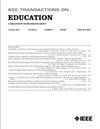在编程教学中通过计算思维模拟解决问题的方法
IF 2.1
2区 工程技术
Q2 EDUCATION, SCIENTIFIC DISCIPLINES
引用次数: 0
摘要
贡献:从主要计算思维(CT)概念中衍生出的问题解决方法(PSA)模型。该模型可用于制定不同算法问题的解决方案,并将其转化为有效的主动学习方法。背景:不同的编程教学方法广泛存在,然而,能够通过计算制定算法解决方案并将其转化为代码对学生来说至关重要。研究问题:培养学生解决问题和编程技能的有效教学方法是什么?计算机辅助设计(CT)概念如何有助于制定编程问题的 PSA 模型并将其转化为有效的教学方法?如何识别利用 PSA 模型的有效教学方法并将其与其他方法区分开来?教学方法:一项初步研究指出了在编程教学中遇到的困难,启发了使用 CT 概念的 PSA 模型的制定。通过排序算法,对基于问题和基于游戏的编程工作坊进行了实验研究,这些工作坊利用了 PSA 模型,每个实验小组由 30 名学生组成。对照组是一个由 30 名学生组成的基于语法的编程工作坊。所有参与者都是通过包含基本编程问题的前测招募的。参加者必须在研讨会后回答后测问题。研究结果结果显示,在基于语法的学习(SBL)方面,学员在前测和后测之间没有明显差异。但是,基于问题的学习(PBL)和基于游戏的学习(GBL)工作坊的前测和后测之间存在明显差异。三个工作坊的前测成绩均无明显差异。对后测的分析进一步证实,实验组(PBL 和 GBL)的分数与对照组相比有显著差异。然而,实验组(PBL 和 GBL)之间的后测结果没有明显差异。本文章由计算机程序翻译,如有差异,请以英文原文为准。
Modeling a Problem-Solving Approach Through Computational Thinking for Teaching Programming
Contribution: A problem-solving approach (PSA) model derived from major computational thinking (CT) concepts. This model can be utilized to formulate solutions for different algorithmic problems and translate them into effective active learning methods. Background: Different teaching approaches for programming are widely available; however, being able to formulate an algorithmic solution computationally and then transform it into code is essential for students. Research Questions: What are the effective teaching approaches for fostering the development of problem-solving and programming skills? How do CT concepts contribute to the formulation of a PSA model for programming problems and its translation into an effective teaching method? How can an effective teaching method that utilizes the PSA model be identified and distinguished from other approaches? Methodology: A preliminary study pointed out the difficulties experienced when teaching programming, inspiring the formulation of a PSA model that used CT concepts. An experimental study on problem-based and game-based programming workshops that utilized the PSA model through sorting algorithms was performed on experimental groups consisting of 30 students each. A syntax-based programming workshop consisting of 30 students was used as the control group. All the participants were recruited through a pretest that incorporated basic programming questions. The participants had to answer a posttest after the workshop. Findings: The results showed that the participants exhibited no significant difference between the pretest and posttest for the syntax-based learning (SBL). However, there is a significant difference between the pretest and posttest of both the problem-based learning (PBL) and the game-based learning (GBL) workshops. There was no significant difference significant difference for the pretest scores of all three workshops. The analysis of the posttest further confirmed that the experimental groups (PBL and GBL) exhibited significant difference in the scores compared to the control group. However, the posttest results did not differ significantly between the experimental groups (PBL and GBL).
求助全文
通过发布文献求助,成功后即可免费获取论文全文。
去求助
来源期刊

IEEE Transactions on Education
工程技术-工程:电子与电气
CiteScore
5.80
自引率
7.70%
发文量
90
审稿时长
1 months
期刊介绍:
The IEEE Transactions on Education (ToE) publishes significant and original scholarly contributions to education in electrical and electronics engineering, computer engineering, computer science, and other fields within the scope of interest of IEEE. Contributions must address discovery, integration, and/or application of knowledge in education in these fields. Articles must support contributions and assertions with compelling evidence and provide explicit, transparent descriptions of the processes through which the evidence is collected, analyzed, and interpreted. While characteristics of compelling evidence cannot be described to address every conceivable situation, generally assessment of the work being reported must go beyond student self-report and attitudinal data.
 求助内容:
求助内容: 应助结果提醒方式:
应助结果提醒方式:


